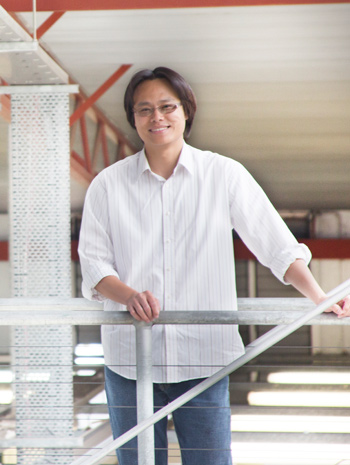Researcher Highlights
A concrete sense of responsibility
Dr Patrick Tang
Eco-conscious and exceptionally hard working, Dr Patrick Tang is looking to accommodate both structural and functional needs in his research and practical design work on building materials

At the very core of Dr Patrick Tang’s studies is the environment. He’s tying research on global energy demands to research on concrete technology and design, ambitiously and admirably seeking to find the least costly means of heating and cooling buildings.
“Energy efficiency has become a primary objective for policymakers at regional, national and international levels,” he concedes.
Nowadays, the construction industry is one of the dominant energy consumers in the world and this is only expected to increase as people continue to spend more time indoors and act on their preferences for thermal comfort.
“It is also concerning that Australia is currently failing to meet its emissions reduction targets.”
“Despite all of these facts, however, there is still not much in the way of practical research on energy efficient building materials, such as cementitious composites.”
“I’m determined to fill this gap.”
Under construction
Patrick’s research career began in 1999, when he commenced a PhD at the City University of Hong Kong (CityU). Principally focused on construction materials engineering during his three-year probe, the industrious academic sought to develop a new class of structural grade lightweight concretes with fibre-reinforced composite materials.
“These are 1,435 to 2,100kg/m3 with corresponding strengths of 20 MPa minimum,” he describes.
“Perhaps most impressively, however, is the fact that they are capable of fulfilling both large-scale structural and functional requirements.”
Joining CityU’s prestigious Department of Civil and Architectural Engineering as a Senior Research Assistant and then Lecturer after receiving his award in 2002, Patrick looked to tackle another big assignment – this time on self-compacting concrete.
“This particular type has the ability to revolutionise building construction by increasing cost-effectiveness and drastically reducing noise nuisance,” he comments.
“Performance of its mixes were thoroughly analysed in laboratory and field tests.”
“From this, comprehensive design and application guidelines were developed for Hong Kong’s Housing Authority.”
Heavy lifting
Patrick relocated to the University of Newcastle in 2009, signing on to become a Lecturer and then Senior Lecturer in Construction Management within its School of Architecture and Built Environment. The talented mid-career researcher has since led a handful of successful endeavours, most recently entering into a long-term collaborative partnership with field experts from mainland China and Hong Kong.
“I also won an Australian Research Council Discovery Project Grant in late 2015,” he shares.
“This is for the creation of structural-functional integrated concrete (TESA).”
“As its name aptly suggests, it will be a structural material and a functional material.”
Undertaking a number of microstructure, mechanical, thermal and durability studies, Patrick is planning to investigate and optimise these properties specifically in TESA concrete.
“This subtype is made of porous structural lightweight aggregate, which is impregnated with liquid phase change materials and coated with epoxy resins and mineral admixtures,” he explains.
“The aim is to design it in a way that ensures consistent and adequate indoor temperature control.”
“We’ll be developing it over the next three years.”
Adding another category to his ever-expanding repertoire of concretes and cement, Patrick is hoping to research sustainable construction materials in the not-so-distant future.
“Photovoltaics, which involve the direct conversion of sunlight into electricity, have been receiving a lot of attention lately,” he elaborates.
“They’re really exciting because they serve multiple purposes, such as efficient energy conversion.”
“I’m looking forward to seeing where this project takes me.”
The University of Newcastle acknowledges the traditional custodians of the lands within our footprint areas: Awabakal, Darkinjung, Biripai, Worimi, Wonnarua, and Eora Nations. We also pay respect to the wisdom of our Elders past and present.
